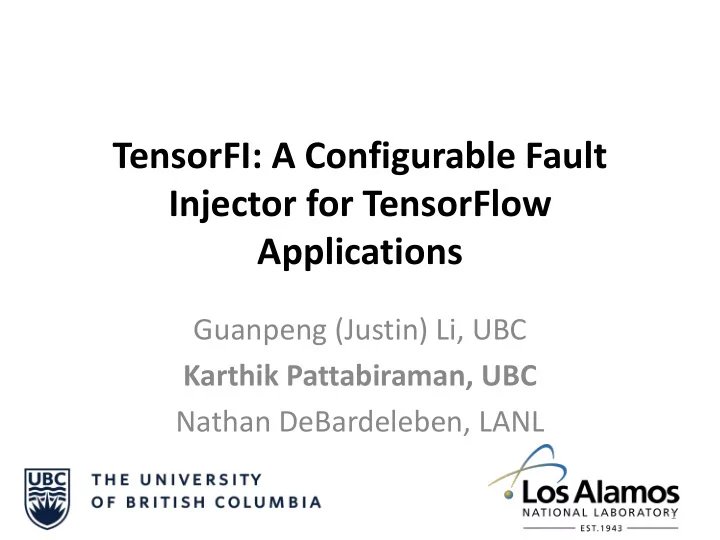

TensorFI: A Configurable Fault Injector for TensorFlow Applications Guanpeng (Justin) Li, UBC Karthik Pattabiraman, UBC Nathan DeBardeleben, LANL 1
Motivation • Machine learning taking computing by storm – Many frameworks developed for ML algorithms – Lots of open data sets and standard architectures • ML applications used in safety-critical systems 2
Error Consequences Example: Self Driving Cars Binary Point Sign bit Fractional bits Single bit-flip fault à Misclassification of image (by DNNs) Source: Guanpeng Li et al., “Understanding Error Propagation in Deep learning Neural Networks (DNN) Accelerators and Applications”, SC 2017. 3
Our Focus: TensorFlow (TF) • Open-source ML framework from Google – Extensive support for many ML algorithms – Optimized for execution on CPUs, GPUs, etc. – Many other frameworks target TF – Significant user-base (> 1500 Github repos) 4
What is TF ? • TensorFlow (TF) - framework for executing dataflow graphs – ML algorithms expressed as dataflow graphs – Can be executed on different platforms – Nodes can implement different algorithms 5
Goals • Build a fault injector for injecting both hardware and software faults into the TF graph – High-level representation of the faults – Fault modeled as operator output perturbation • Design goals – Portability – no dependence on TF internals – Minimal impact on execution speed of TF – Ease of use, compatibility with other frameworks 6
Challenges • TF is basically a Python wrapper on C++ code – C++ code is highly system and platform specific – Wrapped under many layers – hard to understand • Python interface offers limited control – Cannot modify operators “in place” in the graph – Cannot modify graph inputs and outputs at runtime – No easy way to intercept a graph once it starts executing (a lot of the “magic” happens in C++ code) 7
Approach: TensorFI • Fault injector for TensorFlow applications • Operates in 2 phases: – Instrumentation phase: Modifies TF graph to insert fault injection nodes into it – Execution phase: Calls the fault injection graph at runtime to emulate TF operators and inject faults Instrumentation Execution Phase Phase 8
TensorFI: Instrumentation Phase • Idea: Makes a copy of the TF graph and inserts nodes for performing the fault injection faulty orig. * Placeholder Node x * + + Const Const a b 9
TensorFI: Execution Phase • Idea: Emulate the operation of the original TF operators in the fault injection nodes – Inject faults into the output of operators faulty orig. * Placeholder Node x * Inject fault + + into ADD Const Const a b 10
TensorFI: Post-Processing • Inject faults one at a time during each run – Log files to record the specifics of each injection • Gather statistics about the following : – Injections: Total number of injections – Incorrect: How many resulted in wrong values – Difference: Diff between correct and wrong value • Need to specify application specific checks for determining difference with FI outcome 11
TensorFI: Usage Model Instrument code Calculate difference Launch injections in parallel 12 Calculate statistics
TensorFI: Config File 13
Example Output: AutoEncoder Fault injection prob. = 0.5 Original image, no faults Fault injection prob. = 0.1 Fault injection prob. = 0.7 Fault injection prob. = 1.0 Reconstructed image (no faults) 14
TensorFI: Open Source (MIT license) https://github.com/DependableSystemsLab/TensorFI 15
Benchmarks • 6 open source datasets – UCI open source ML dataset repository – Can be modeled as classification problems • 3 ML algorithms – k nearest neighbor (kNN) – Neural network (2-layer ANN) – Linear regression 16
Experimental Setup • Fault injection configurations – Repeat 100 FI campaigns per benchmark (One fault per run) – FI rates (prob. of injection): 5%, 10%, 15% and 20% • Metric: Average accuracy drop – Original accuracy without fault injection (OA) – Accuracy after fault injection (FA) – Average accuracy drop = average of (OA-FA) among all FI runs 17
Results • SDC rate increases are different as fault injection rates increase • SDC rates are different for different models • kNN has lower SDC rates and lower rate of increase 18
Future Work • Investigate the error resilience of different ML algorithms under faults – Understand reasons for difference in resilience – Build a mathematical model of resilience – Choose algorithms for optimal resilience • Understand how different hyper-parameters affect resilience and choose for optimality 19
TensorFI: Summary • Built a configurable fault injector for injecting both h/w and s/w faults into the TF graph – High-level representation of the faults • Design goals – Portability – no dependence on TF internals – Speed of execution not affected under no faults – Ease of use, compatibility with other frameworks Available at: https://github.com/DependableSystemsLab/TensorFI 20 Questions ? karthikp@ece.ubc.ca
Recommend
More recommend